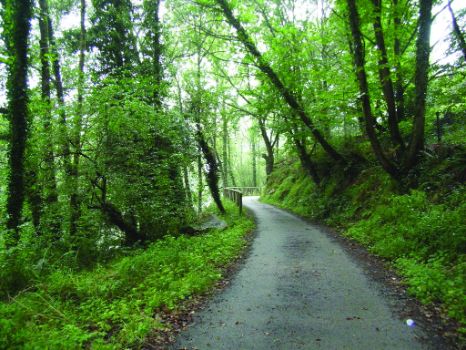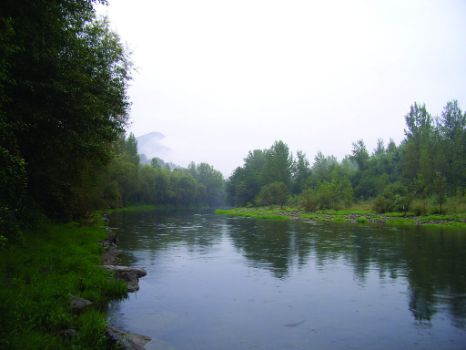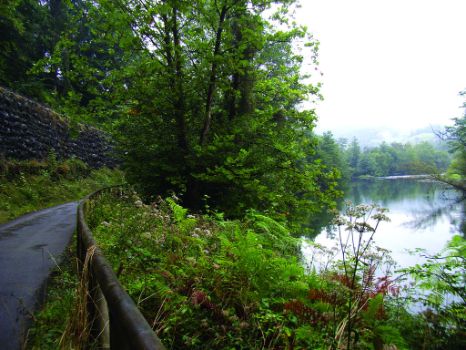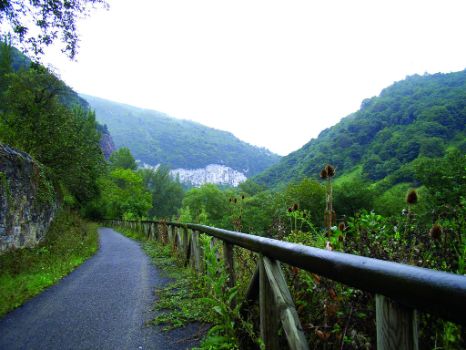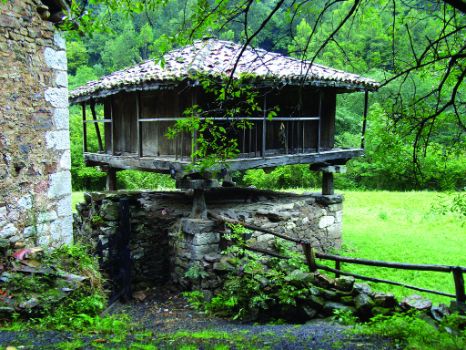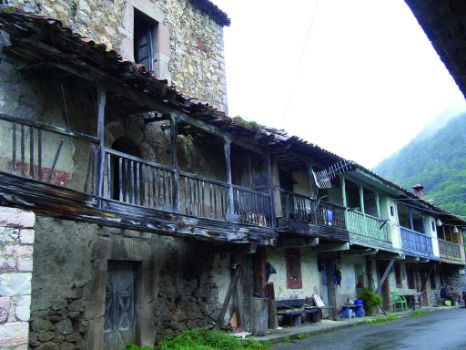Net of Natural
Trails

River Nalón Nature Trail (Fuso - Tuñón)
Description
Romanesque churches and millenarian yews
This 16-kilometre route links the Fuso de la Reina-Parque de Invierno de Oviedo Greenway with the Bear Trail that begins in Tuñón. It runs through meadows, chestnut woods and riparian forests along the banks of the rivers Nalón and Trubia.

The route begins at Fuso de la Reina, next to the FEVE (Ferrocarriles Españoles de Vía Estrecha) railway station, and runs parallel to the railway tracks until it leaves the town behind. Immediately after, it continues parallel to a hydroelectric canal fed by the Nalón until it reaches an intersection. Here, the route veers right onto a level crossing. It then continues parallel to the railway line until it slowly drifts away from the tracks and the water canal towards a metal footbridge across the river. Numerous wetland bird species, such as mallards (Anas platyrhynchos), grey herons (Ardea cinerea), common moorhens (Gallinula chloropus), and grey wagtails (Motacilla cinerea) can be seen, and, with a little luck, even an otter (Lutra lutra).
The Trail runs along the right bank of the Nalón, immersed in a well-developed riparian forest, mainly populated by alders (Alnus glutinosa), black poplars (Populus sp.) and ashes (Fraxinus sp..). Past a junction, the route continues along the left bank until it reaches a bridge with views of the peculiar Priorio castle. After passing under a bridge over the Nalón, it heads down the road to Caces.
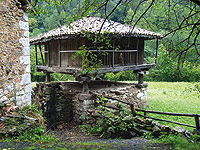
At the entrance of the town, next to a playground, the route turns right and traverses through a few streets with fine examples of traditional architecture, including several "hórreos" (granaries) still in use. The route continues straight ahead at the first intersection, then veers right at the next two junctions and continues along a dirt road that links with a paved road that runs alongside the Nalón.
With no room for confusion, the paved road winds down parallel to the river through a lush area populated with chestnut trees (Castanea sativa), between meadows and fields, including a kiwi farm that exports tons of fruits to Europe. Further on, the path reaches the junction with the road leading up to Pintoria, from where it continues to the right, always parallel to the river, towards Trubia.
The path stumbles again onto the railway tracks, and, immediately after, reaches the industrial facilities of Química del Nalón, located on the outskirts of Trubia. Once in town, it runs through its streets towards the train station, where the Trail can cross the tracks either via a metal footbridge or at the level crossing. It continues through the town centre towards the River Trubia, at the edge of the town.

The route follows the right bank of the river, leaving behind several bridges, past various industrial facilities, to reach the intersection with the road to Perlín. It now veers right to the church of Santa María de Trubia, where the Trail turns left behind an abandoned farmhouse. From here to San Andrés, the Trail traverses meadows, croplands and a lush mixed forest dominated by maples (Acer sp.), ashes and chestnuts.
In San Andrés, the route ventures onto a path to the left, parallel to the road, which leads to an old quarry with a wooden footbridge over the road and the River Trubia, then continues left along a paved road.
The path then winds along the floor of Trubia Valley, moving towards the limestone walls of Peña de la Escalera and the slopes of La Recusa and Las Garradas. It then traverses the old railway tunnel, and continues up the valley while slowly approaching the River Trubia. The route crosses a metal bridge over the river and reaches Tuñón recreation area, next to AS-228, where this Nature Trail ends and one of the sections of the Bear Trail begins.
Profile

Highlights
Further information
Pre-Romanesque church of Santo Adriano de Tuñón
This temple, built by King Alphonse III and his wife, Queen Jimena, over a former Benedictine monastery, was consecrated by three bishops in 891, and renovated in 1108.
King Alphonse III the Great, the last Astur king, dedicated the church to the martyrs Hadrian (Roman official) and his wife Natalia.
Santo Adriano de Tuñón, declared a National Monument in June 1931, was subsequently restored (1949 and 1954).
The temple from the outside
This three nave building, located in the rural area of Santo Adriano de Tuñón, has an extremely elongated façade, owing to successive alterations. It also has an abutting building on one side. It is likely that a similar building existed on the opposite side, but was demolished to make way for the cemetery.
The temple is built of masonry, rough ashlar and dressed ashlar in the corners.
The external wall of the upper chamber appears in the headwall, which also has a two casement mullioned window and a central column. The light falls onto the central nave through jalousie windows.
Inside the temple
Santo Adriano has a floor plan that reflects the classic conception of a basilica in Asturian pre-Romanesque style. It is divided into three naves linked by arches on columns, which in this building have no fascia.
A wooden roof covers the nave, with the exception of the rectangular, tripartite apse covered by a barrel vault.
The temple is barely decorated. The pictorial motifs of the chancel, depicting the Allegory of the Sun and Moon, are worthy of note. Under these motifs is a battlement frieze of Mozarabic influence, on which flowers and scrolls can be seen.
The other decorative elements of Santo Adriano de Tuñón are a cross, similar to the Victory Cross, and the remains of the original marble partition.
Bermiego Yew
The Bermiego yew, known in Asturian as «Teixu l’Iglesia», is a millenarian tree found in the town of Bermiego (County Quirós).
It grows in the western foothills of Sierra del Aramo, on the outskirts of the village, and within the precincts of the town church.
This yew (Taxus baccata), widely considered as the oldest yew in Europe, has an almost perfect morphology. The canopy measures 15 m in diameter. The tree is 10 metres high, and the perimeter of the trunk is 6.5 to 7 m Declared a Natural Monument, it is a protected species that is included in the Asturias Natural Resources Management Plan.



